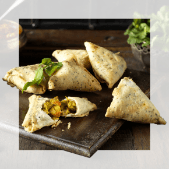The 2018 World Cup final was a real David and Goliath match (with Goliath prevailing this time) and this is also reflected in the kitchen, but when it comes to culinary traditions, the two sides have more in common than you may at first think.
Croatia, with a population of just 4 million was in its first World Cup final while France, who also won the competition in 1998, had a population of almost 70 million at home cheering them on.
Off the pitch, France is often seen as the culinary capital of the world. Its reputation for wonderful food and cooking is based on technical skills and extravagant, expensive ingredients. In 2010, France was the first nation to have its gastronomy recognised by UNESCO as an “intangible part of it cultural heritage”, reinforcing the international reputation of French cuisine.
In contrast, few people outside Croatia are aware of its food and because its traditional dishes vary from one region to another, it’s a country without a strong national culinary identity. While there are some dishes you’ll find throughout Croatia such as sarma (vine leaf wrapped around rice or meat filling), many dishes found in one region are not even known in another part of the country. Although traditional Croatian cuisine is wide and varied, it’s hard to distinguish dishes that are exclusive to Croatia because it has been influenced by tastes and traditions from neighboring countries and its history.
But while these two footballing nations may seem worlds apart in food terms, there are some remarkable similarities.
Both nations love their unusual ingredients which might upset the more squeamish diner. Every seafood restaurant in Croatia has a crni rizot (black, squid risotto) on its menu whilst escargots are a delicacy across France with the land snails cooked in garlic butter and served as a starter.
France’s traditional beef stew, beef bourguignon, takes its name from two main specialties produced in the French region of Burgundy – Charolais beef and red wine. It’s not a million miles away from Croatia’s pasticad s njokima. The most popular dish in the Dalmatian region involves marinated wine vinegar beef fillets being braised for hours in red wine and served with homemade gnocchi.
When it comes to the soup course, in Croatia they serve manestra – a bean soup, cooked slowly for hours on a low fire, flavoured with a paste made of pancetta, garlic, and parsley. In France, a traditional onion soup should also take hours to cook and should always be served with a large cheese crouton floating in it, to allow the cheese to melt into the soup.
For sweet treats, French patisseries are crammed with amazing looking, and tasting, pastries filled with chocolate, cream and confectioner’s custard, whilst in Croatia you are likely to enjoy strukli, a pastry, filled with cottage cheese and sour cream, which originated in Slovenia and is meant to be delicious!
Meanwhile the most common sweets you’ll find in coastal Croatia are fritule – ball shaped dough made with flour, raisins, a touch of local schnapps and lemon zest, and then deep fried. These sweet fritters are addictive and very similar to French beignets – deep fried dough dusted with sugar, which can be found throughout the country.
So it seems that whilst at first glance these two countries are worlds apart when it comes to food at least, they may be evenly matched!
Here’s my French/Croatian fusion recipe:
Buckwheat galettes with smoked salmon & capers on a bed of Crni Rizot (squid ink risotto)
- 500g salmon fillet with skin
- 3 tablespoons salted butter, divided
- 8 spring onions, thinly sliced
- 250g smoked salmon, finely chopped, divided
- 3 tablespoons lemon juice
- 2 tablespoons drained capers
- 2 tablespoons chopped fresh chives plus some for garnish
- 8 Basic Buckwheat Crepes (see recipe below)
- 425g buckwheat flour
- 3 large eggs
- 85g vegetable oil plus additional for skillet
- 250g nonfat milk
- 425g (or more) water
- 1/4 teaspoon salt
Method (for the salmon and capers):
- Score flesh side of salmon fillet at 1 1/2-inch intervals 1/2 inch deep in crisscross pattern; sprinkle with salt and pepper.
- Heat large non-stick skillet over medium-high heat. Add salmon, skin side down. Cook until skin is lightly browned, approx. 3 minutes. Turn salmon over and partially cook until just warm, 2 to 3 minutes. Transfer to plate. Cut salmon, including skin, into 1/2-inch pieces and allow to cool.
- Heat same skillet over medium-high heat. Add 1 tablespoon butter, green onions and 2/3 of smoked salmon. Sauté 2 minutes; add reserved salmon. Toss until heated through. Remove from heat; add lemon juice, capers, and chopped dill. Season with salt and pepper.
- Melt 1 teaspoon butter in medium skillet over medium heat. Working with 1 crepe at a time, add to skillet and heat through. Spoon 1/8 of salmon mixture onto bottom third of each crepe. Roll up and place on plate. Garnish with reserved smoked salmon and dill sprigs. Repeat with remaining butter, crepes, and salmon.
For the crepes:
- Place flour in medium bowl. Whisk in eggs, most of the oil, milk, water, and salt.
- Heat 10-inch-diameter nonstick skillet over medium-high heat; brush pan with oil. Add 1/4 cupful batter to skillet; tilt to coat bottom. Cook crepe until golden on bottom, adjusting heat to prevent burning, 30 to 45 seconds. Using spatula, turn crepe over; cook 30 seconds. Transfer to plate.
- Repeat with remaining batter, stacking crepes between sheets of plastic wrap , cover and chill. They can be made one day ahead.
Risotto:
- 500g squid or calamari or cuttlefish
- 1 large onions finely diced
- 30g olive oil
- 2 garlic cloves, minced
- fresh parsley, chopped
- 30g white wine
- 200g arborio rice
- 4g (about 1 tsp) squid ink, or to taste
- 170g fish stock
- salt, black pepper
- a knob of butter
- Clean the squid or calamari (reserve ink sac). Cut them into stripes.
- Sauté onion in the oil until translucent. Add the squid or calamari and cook for 15 minutes.
- Add garlic, parsley, salt (be careful with the salt because stock is salty), wine, pepper and enough water to cover calamari and cook until squid or calamari are soft (squid will take longer time to cook then calamari).
- Add the rice, the ink from the ink sac and continue cooking on low to medium heat. Add hot stock, ladle by ladle, stirring until absorbed. Remove from heat when rice is cooked al dente. Stir in a knob of butter. Cover and let stand for 10 minutes before serving.
Assemble:
- Spoon the risotto into the centre of the plates
- Place a smoked salmon crepe on top of each risotto mound
- Drizzle with olive oil and sprinkle with chopped chives
- Garnish plates with diced tomato if you wish
About Neil Shaefer
Marketing & Communications Executive of SK Foods.
Your food. Our Passion.






